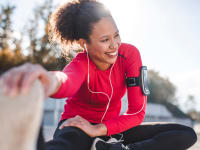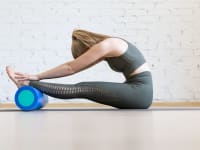Products are chosen independently by our editors. Purchases made through our links may earn us a commission.
If you've scrolled through Instagram or Facebook recently, you may have noticed that your feed is dominated with ads for new-fangled massage guns and fancy rolling devices. (Blame—or thank—the algorithm.) These gadgets often claim to help with post-workout recovery, and, more specifically, to ease myofascial pain, or pain caused by tightness in the fascia tissue that surrounds and supports your muscles. Though this may sound like a complex issue reserved for only the highly active, myofascial pain affects an estimated 85% of people at some point in their lives—in other words, most of us could use a massage.
Massage guns and foam rollers are great options. But not everyone needs to commit to the potentially hefty price tag that goes along with a fancy implement. In fact, all you really need for a cost-effective massage is a hand-sized ball with a firm texture.
How can you get a good massage using a ball?
Simply put, you use a ball as a tool to self-massage tight spots in your muscles and release the myofascia. Although various specialized massage balls abound, you can get great results from using balls you probably already have lying around your house, such as tennis balls, lacrosse balls, golf balls, baseballs, or squash balls.
The end goal of a good massage is to trigger those tight myofascial tissues to release. Myofascial release helps reduce pain by easing tension and tightness in "trigger points," which are more commonly called knots. “Myofascial pain frequently comes from what I call ‘pattern overload’ or when you repeat a pattern of activity or exercise over and over again, and the pain occurs when the connection between the muscle and the fascia becomes disrupted,” says Tom Kirsch, a sports physical therapist based in Texas. “The difference between myofascial release and stretching is like when you have a knot in a rope—if you stretch the rope the knot will just get tighter, which you don’t want. Myofascial release will actually loosen up the knot and reset the tissue.”
If relief from myofascial pain isn't enough of an incentive, consider the long-term benefits. Rolling out tight and sore spots regularly can help prevent further issues down the road, according to Oak Park, Illinois physical therapist Peter Allan Schmitt. “If we properly care for our bodies now, we can avoid the need for invasive and painful surgeries in the future,” he says.
What type of ball is best for self-massage?
You can use whatever old sports ball you have handy. But if you want to get the most out of your myofascial release, you can match the ball to the muscle group you want to target.
Schmitt says his favorite ball to use is a tennis ball. “They're the perfect size for most areas and they have a little bit of give, which I like,” he says. Schmitt uses tennis balls with his patients for most areas, but for smaller body parts, such as hands and feet, he recommends using a handball or a squash ball because they are even softer.
Like Schmitt, Kirsch likes tennis balls for more sensitive areas, such as the back, but his recommendations depend on the size of the muscle group and what his patient can withstand. For larger areas like glutes or hamstrings, which may hold deeper trigger points, Kirsch likes baseballs, softballs, or even basketballs, but for smaller areas he prefers Pinky balls (a smooth latex-based ball intended for massage) or, in certain cases, golf balls. “What I like depends on what area I am working on and the patient’s body type,” Kirsch says.
How to safely and effectively roll out tight spots in big muscles
The first step in relieving your myofascial pain is to identify the spot you want to roll. “The words we like to use are ‘exquisitely tender,’” Schmitt says. “You could be two centimeters away and it could be tender, but you won’t be as effective as when you hit the trigger point.” In other words, when you find that knot, you'll know—it'll probably be slightly raised and painful to the touch. However, there's no real "wrong" way to go about rolling. Even if you miss the trigger point, you'll feel relief by rolling around the area. For most areas, you can also use a foam roller, which puts pressure on the muscle to start myofascial release.
The key is persistence. “You want to spend at least a minute, even a minute and a half on a given point,” Schmitt says. “Start out with a pressure that is pretty uncomfortable, but not so uncomfortable that you’re squirming or tears are streaming down your face. As you work it, you’ll find that [the trigger point] respond[s] by becoming gradually less reactive and that’s how you know that you’ve made an impact.”
Once you've worked on one trigger point for up to two minutes, Schmitt recommends moving to an adjacent spot. Then, follow it up with a quick static stretch, such as a seated toe touch or standing figure four stretch. This will make you feel even more limber and relaxed.
How to roll out your feet
Whether you're an avid runner or simply on your feet all day at work, the feet are one of the most important areas to regularly roll. “Plantar fasciitis [or inflammation in the tissue that connects the toes to the heels] is a common occurrence and it is very painful, so you want to make sure you take care of your feet,” Schmitt says.
For the best rolling experience, Schmitt recommends sitting down and placing your ball of choice under your bare foot and rolling lengthwise from your heel to the ball of your foot. “You are going to find there will be several sore spots on your foot, especially at the metatarsal head and in the midsection of the foot through your arch because that’s where your fascia is,” he says.
Schmitt's favorite tool for the feet is a handball but anything that's firm but has a little give will help you out here—try a tennis ball, handball, or squash ball.
How to roll out your hamstrings
Soreness in your hamstrings, or the muscles on the back of your thighs, is never fun. It can also seriously limit your mobility. To get the best myofascial release in the hamstrings, Kirsch has patients sit in a long seated position on the floor, place their ball of choice underneath the muscle and roll vertically and horizontally across the area.
“I like to use something a little harder and a little stronger for the hamstrings because they are so protected,” Kirsch says. “So I will use a softball or a baseball, but if that is too much you can always use something softer like a tennis ball.”
How to roll out your calves
Chronically sore calves can negatively impact your ease of movement. When it comes to these muscles, Kirsch recommends sitting in a long seated position on a hard surface. For added pressure, you can fold your other leg over the shin of your rolling leg.
“Sometimes I will use a baseball, but if that is too big or too hard you can use a Pinky ball or a lacrosse ball,” Kirsch says. “You will place the ball under your calf and roll up-and-down and side-to-side on the muscle.”
How to roll out your hips and glutes
Sitting at a desk all day can result in tightness and stiffness in your hips. Kirsch’s preferred technique for rolling out the glutes and hip structures, like the Tensor Fasciae Latae (TFL), is to have patients lie on their side with the ball underneath them and roll both the length and width of the muscle.
Due to the size of these muscle groups, Kirsch likes to use lacrosse balls or Pinky balls, but says that tennis balls can work as well.
How to roll your back
The back is a source of tension and tightness for a lot of people, particularly around the spine and shoulders. Kirsch likes to use two balls placed in a sock with the open end tied shut to release this tautness. “You lie on your back and one ball should be on either side of the spin and you roll up and down through your rhomboids to your lower back,” Kirsch says. “You can also place the balls on one side and roll laterally.”
Kirsch prefers to use tennis balls on the back because the spinal area is too tender for golf and lacrosse balls.
The product experts at Reviewed have all your shopping needs covered. Follow Reviewed on Facebook, Twitter, and Instagram for the latest deals, product reviews, and more.


